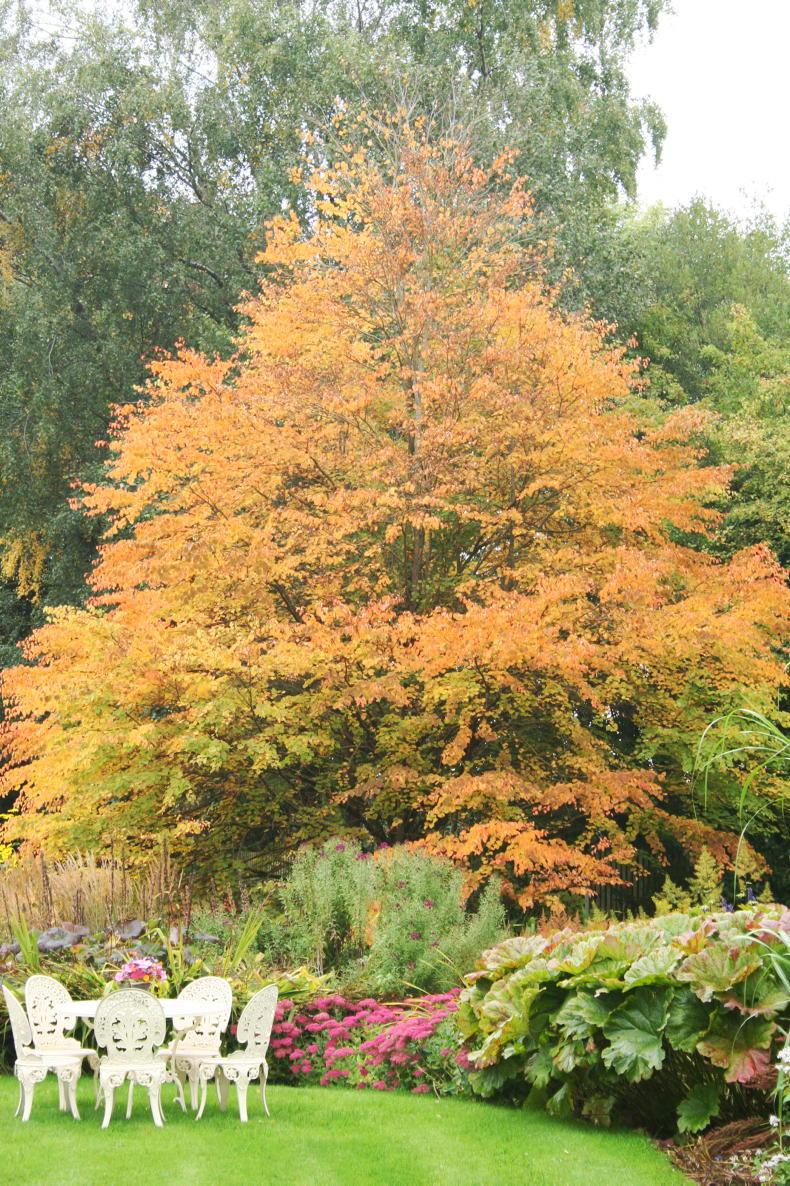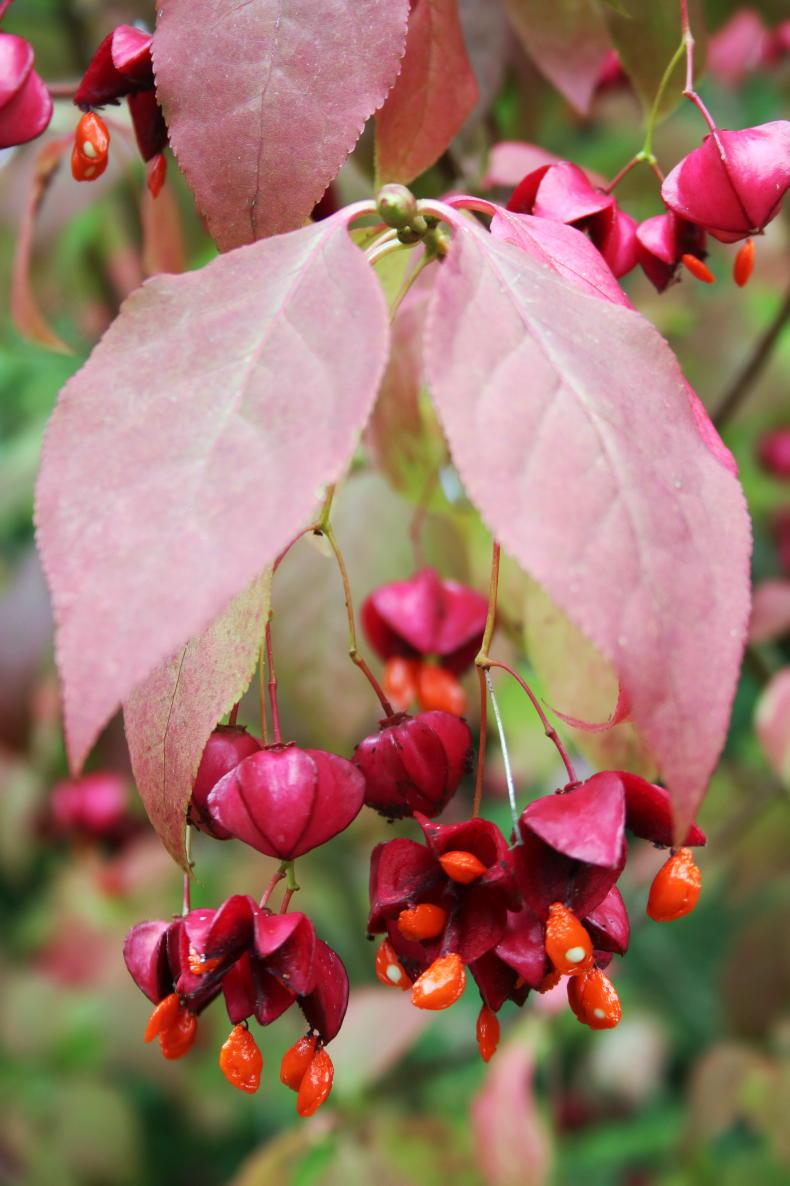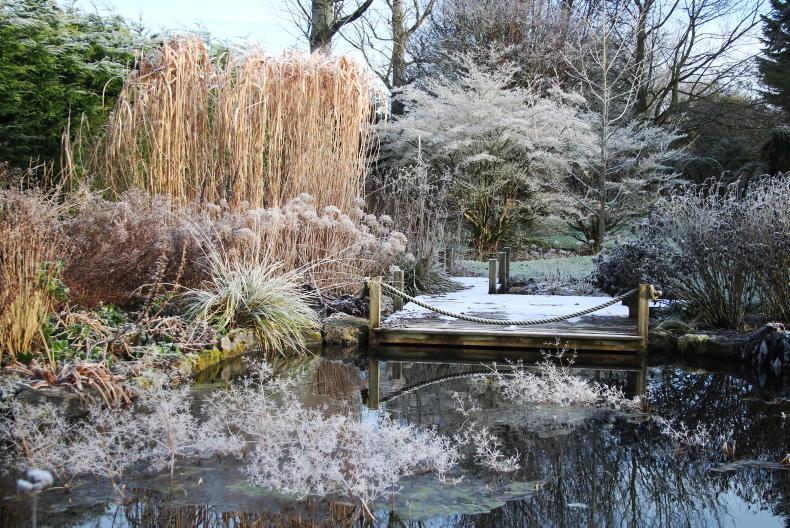In autumn, the beauty of deciduous trees comes to the fore as they ignite the garden into a blaze of colour. It’s the perfect time of year to celebrate National Tree Day, taking place on 6 October, when we are prompted to plant a tree or take a walk to notice and appreciate the many trees that reach their peak of beauty at this time.

Cercidiphyllum japonicum
One of the most eye-catching trees for autumn colour in our garden is the katsura tree, Cercidiphyllum japonicum.
Throughout summer, it provides an unremarkable backdrop for all the bright flowers in bloom but come autumn, the heart-shaped, green leaves take on fiery shades of yellow, orange and purple. As the leaves fall, they give off the tantalising scent of burnt sugar or candyfloss. It grows slowly to around 5m in height.
I’m a huge fan of our native spindle tree, Euonymus europaeus, at its loveliest in autumn when the dark green leaves turn a warm russet at the same time as its pink fruits ripen and open to reveal bright orange seeds inside.
Although more commonly grown as a large, bushy shrub or hedgerow plant, it can be trained to form a small, multi-stem tree to around 4m with an umbrella canopy. “Red Cascade” is a more richly coloured garden form and my favourite spindle is the stunningly beautiful Euonymus planipes.

Euonymus planipes
For multi-seasonal interest, Malus “Evereste” is a very garden-worthy cultivar of ornamental crab apple tree with unusually large, dazzling white flowers that open from red buds in late spring. These are followed in autumn by heavy crops of small, red flushed, orange-yellow fruits that can be used for making crab apple jelly. The tree has a compact, conical habit making it an ideal choice for small gardens.
Autumn planting
Many new gardeners may be surprised to learn that autumn is the traditional season for planting shrubs, perennials and trees.
The soil is moist and still holds enough of summer’s warmth to encourage newly planted trees and shrubs to extend their roots out into the ground and settle in well before winter. At the same time, growth above ground begins to slow and the plants divert all their energy into establishing stronger root systems.

Many new gardeners may be surprised to learn that autumn is the traditional season for planting shrubs, perennials and trees.
This head start on root development translates to faster and more robust growth come spring and greater resistance to drought. When planting in spring, most of the plant’s energy goes into the above ground growth of leaves, flowers and branches. Root development is slower, making plants more vulnerable to dry summers later.
That said, in my colder midlands garden, I’ve generally opted for planting new additions in mid to late spring, applying the rationale that the plants quickly start into active growth and have a long growing season to settle in as opposed to sitting in cold, wet ground over winter when planted in autumn.
However, having spent much of this summer arduously watering new additions through a succession of prolonged dry periods and with too many gaps in borders that remained unplanted because the window for spring planting has become quite small due to increasing dryness at this time, I’ve decided autumn is when I will do all major new plantings from now on.
October is going to be a busy month getting all those plants that have been sitting too long in pots into the ground, but it will be worth it when all the gaps are filled for next season.
Join a local gardening club
It’s great to see gardening clubs back up and running around the country with packed schedules of activities through autumn and winter.
Gardening and plants connect people of all ages and backgrounds and joining your local garden club will give you the opportunity to socialise and pick up tips and advice. It won’t matter if you are new to gardening or experienced as I find there is always something new to learn from the regular talks and demonstrations from gardening experts.
Many local clubs also organise trips to gardens, including those not normally open to the public, and several have secured discounts for members at local plant nurseries and garden centres as well as access for group-buy discounts for seeds, bulbs, plants and other garden requirements.
When it comes to your local club, as opposed to online groups, most of the members live nearby and share the same challenges of soil, weather and pests as you. People swap advice as freely as plants, cuttings and seeds.
So, if you enjoy gardening, get out there and join your local group where you’re sure to find a welcome.
Falling autumn leaves can be a nuisance, but we put them to good use by composting them until they turn into a lovely, crumbly leafmould that can be used as a mulch, soil improver or potting compost.
We use the large, porous, one-ton builders’ bags to contain and store composting leaves in a cool, shady spot.
When packing the bag with leaves, water in the layers and moisten it periodically if it becomes dry.
If you shred the leaves, by running over them with a lawnmower, before adding them to the bag, they will decompose more quickly. Leave the bag open to the elements or cover it with some old carpet.
After one year, most leafmould should be crumbly enough to use as a mulch or soil conditioner. It takes a further year to rot down to a finer texture that can be used as potting compost.
Clean and oil wooden garden furniture before storing it away for winter. Prune roses back by about one-third to reduce wind resistance and avoid damage by wind-rock in winter storms.Check tree stakes and ties. They need to be sturdy and tight so that the stems are not damaged by rubbing and hitting against the stake. Gather and sow some ripe berries from rowan trees in pots of compost to be left outside all winter. The frost will work on them and they will sprout in spring. Grow them on for eventual planting out as excellent trees for autumn colour. Clear out overgrown ponds. Plants should cover a maximum of 50% of the surface.6 October: Celebrate National Tree Day by planting a tree or taking a walk in a garden, parkland, woodland or in nature.
27 and 28 October: The Northern Ireland Heritage Gardens Trust 28th Annual Conference. Venue: National Botanic Gardens, Glasnevin, Dublin. Theme: Planting for tomorrow’s world – a global perspective. More information: www.nihgt.org
Garden club events nationwide: Check out listings in the news pages of The Irish Garden magazine, local newspapers, club websites and social media.
Mary Keenan and Ross Doyle run Gash Gardens, Co Laois, open to the public. www.gashgardens.ie
In autumn, the beauty of deciduous trees comes to the fore as they ignite the garden into a blaze of colour. It’s the perfect time of year to celebrate National Tree Day, taking place on 6 October, when we are prompted to plant a tree or take a walk to notice and appreciate the many trees that reach their peak of beauty at this time.

Cercidiphyllum japonicum
One of the most eye-catching trees for autumn colour in our garden is the katsura tree, Cercidiphyllum japonicum.
Throughout summer, it provides an unremarkable backdrop for all the bright flowers in bloom but come autumn, the heart-shaped, green leaves take on fiery shades of yellow, orange and purple. As the leaves fall, they give off the tantalising scent of burnt sugar or candyfloss. It grows slowly to around 5m in height.
I’m a huge fan of our native spindle tree, Euonymus europaeus, at its loveliest in autumn when the dark green leaves turn a warm russet at the same time as its pink fruits ripen and open to reveal bright orange seeds inside.
Although more commonly grown as a large, bushy shrub or hedgerow plant, it can be trained to form a small, multi-stem tree to around 4m with an umbrella canopy. “Red Cascade” is a more richly coloured garden form and my favourite spindle is the stunningly beautiful Euonymus planipes.

Euonymus planipes
For multi-seasonal interest, Malus “Evereste” is a very garden-worthy cultivar of ornamental crab apple tree with unusually large, dazzling white flowers that open from red buds in late spring. These are followed in autumn by heavy crops of small, red flushed, orange-yellow fruits that can be used for making crab apple jelly. The tree has a compact, conical habit making it an ideal choice for small gardens.
Autumn planting
Many new gardeners may be surprised to learn that autumn is the traditional season for planting shrubs, perennials and trees.
The soil is moist and still holds enough of summer’s warmth to encourage newly planted trees and shrubs to extend their roots out into the ground and settle in well before winter. At the same time, growth above ground begins to slow and the plants divert all their energy into establishing stronger root systems.

Many new gardeners may be surprised to learn that autumn is the traditional season for planting shrubs, perennials and trees.
This head start on root development translates to faster and more robust growth come spring and greater resistance to drought. When planting in spring, most of the plant’s energy goes into the above ground growth of leaves, flowers and branches. Root development is slower, making plants more vulnerable to dry summers later.
That said, in my colder midlands garden, I’ve generally opted for planting new additions in mid to late spring, applying the rationale that the plants quickly start into active growth and have a long growing season to settle in as opposed to sitting in cold, wet ground over winter when planted in autumn.
However, having spent much of this summer arduously watering new additions through a succession of prolonged dry periods and with too many gaps in borders that remained unplanted because the window for spring planting has become quite small due to increasing dryness at this time, I’ve decided autumn is when I will do all major new plantings from now on.
October is going to be a busy month getting all those plants that have been sitting too long in pots into the ground, but it will be worth it when all the gaps are filled for next season.
Join a local gardening club
It’s great to see gardening clubs back up and running around the country with packed schedules of activities through autumn and winter.
Gardening and plants connect people of all ages and backgrounds and joining your local garden club will give you the opportunity to socialise and pick up tips and advice. It won’t matter if you are new to gardening or experienced as I find there is always something new to learn from the regular talks and demonstrations from gardening experts.
Many local clubs also organise trips to gardens, including those not normally open to the public, and several have secured discounts for members at local plant nurseries and garden centres as well as access for group-buy discounts for seeds, bulbs, plants and other garden requirements.
When it comes to your local club, as opposed to online groups, most of the members live nearby and share the same challenges of soil, weather and pests as you. People swap advice as freely as plants, cuttings and seeds.
So, if you enjoy gardening, get out there and join your local group where you’re sure to find a welcome.
Falling autumn leaves can be a nuisance, but we put them to good use by composting them until they turn into a lovely, crumbly leafmould that can be used as a mulch, soil improver or potting compost.
We use the large, porous, one-ton builders’ bags to contain and store composting leaves in a cool, shady spot.
When packing the bag with leaves, water in the layers and moisten it periodically if it becomes dry.
If you shred the leaves, by running over them with a lawnmower, before adding them to the bag, they will decompose more quickly. Leave the bag open to the elements or cover it with some old carpet.
After one year, most leafmould should be crumbly enough to use as a mulch or soil conditioner. It takes a further year to rot down to a finer texture that can be used as potting compost.
Clean and oil wooden garden furniture before storing it away for winter. Prune roses back by about one-third to reduce wind resistance and avoid damage by wind-rock in winter storms.Check tree stakes and ties. They need to be sturdy and tight so that the stems are not damaged by rubbing and hitting against the stake. Gather and sow some ripe berries from rowan trees in pots of compost to be left outside all winter. The frost will work on them and they will sprout in spring. Grow them on for eventual planting out as excellent trees for autumn colour. Clear out overgrown ponds. Plants should cover a maximum of 50% of the surface.6 October: Celebrate National Tree Day by planting a tree or taking a walk in a garden, parkland, woodland or in nature.
27 and 28 October: The Northern Ireland Heritage Gardens Trust 28th Annual Conference. Venue: National Botanic Gardens, Glasnevin, Dublin. Theme: Planting for tomorrow’s world – a global perspective. More information: www.nihgt.org
Garden club events nationwide: Check out listings in the news pages of The Irish Garden magazine, local newspapers, club websites and social media.
Mary Keenan and Ross Doyle run Gash Gardens, Co Laois, open to the public. www.gashgardens.ie












SHARING OPTIONS